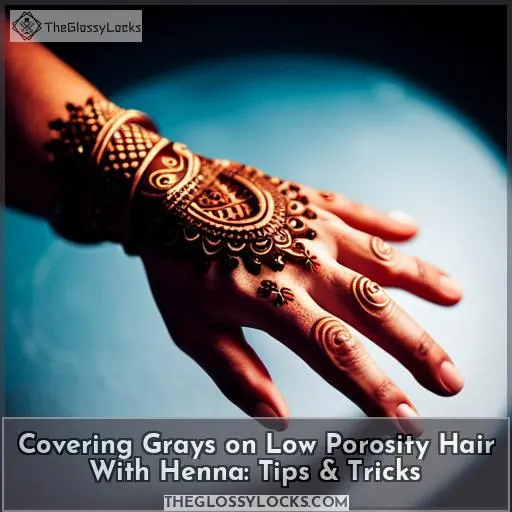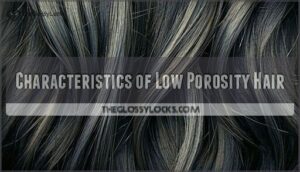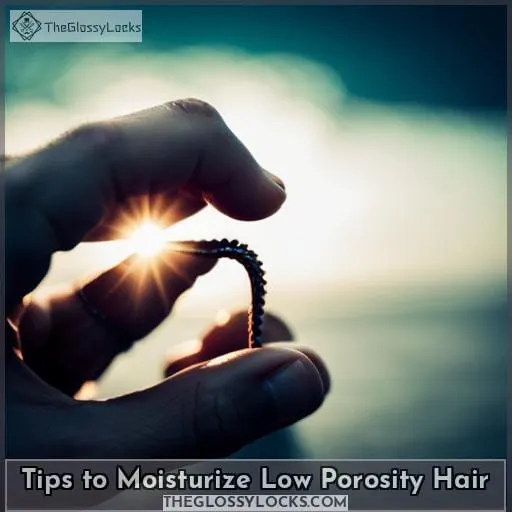This site is supported by our readers. We may earn a commission, at no cost to you, if you purchase through links.
 Struggling to cover your grays on low porosity hair? You’re not alone. Henna has been used for centuries as a natural method of coloring grey hair, but when you have low porosity locks, it can seem like an impossible task.
Struggling to cover your grays on low porosity hair? You’re not alone. Henna has been used for centuries as a natural method of coloring grey hair, but when you have low porosity locks, it can seem like an impossible task.
In this article, we’ll provide all the information needed to help make sure that using henna will actually cover gray hairs on lower porosity tresses – from understanding what causes them in the first place, through to knowing if developer needs mixing into the dye for best results.
Read on and discover how easy it is to use henna color successfully!
Table Of Contents
Key Takeaways
- Henna is a natural method for coloring gray hair on low porosity hair.
- Consulting with a professional is recommended before attempting at-home henna solutions.
- Lighter henna colors work best on finer strands of low porosity hair.
- Henna does not require the use of a developer or synthetic dyes to cover gray hair on low porosity hair.
What is Low Porosity Hair?
Discovering if you have low porosity hair can be confusing, but taking the time to understand it is essential for healthy and vibrant locks. Low porosity hair has a closed cuticle layer, making it difficult for products to penetrate deeply into the strands.
Careful cleansing with sulfate-free shampoo, pre-treatments such as apple cider vinegar rinse or clarified water rinses, and using moisturizing products are all ways that you can work around this challenge.
Heat styling should also be avoided whenever possible, as this will further close your cuticles, preventing any moisture from getting in or out of your strands easily, resulting in dryness and dullness.
Protein treatments may also help open up these tightly sealed cuticles, allowing more hydration into each strand, which may promote healthier-looking tresses over time when done correctly.
Henna powder is often seen as an alternative option for those who have low porosity hair due to its natural ingredients that help coat individual strands while adding shine without additional damage caused by heat tools like dyes containing harsh chemicals do.
While henna does provide some color coverage over gray hairs, results vary depending on one’s unique texture type, so it’s important to consult with a professional before attempting at-home solutions.
Additionally, since henna adheres better on certain textures compared to others, individuals with a lower level of porosity would likely benefit from cutting their split ends prior to application, followed by consistent use of moisturizing products afterwards so that the overall health state remains intact throughout the process.
Characteristics of Low Porosity Hair
Understanding your hair porosity can help you identify the best products and methods to care for it, especially if yours is of the low variety. Low porosity hair has a closed cuticle layer that makes it difficult for moisture, as well as other treatments, to penetrate deeply into strands.
As such, protective styling may be necessary to keep its integrity intact while avoiding split ends or excessive dryness.
Additionally, sealing moisture with pre-poo treatments like apple cider vinegar rinses or clarified water is highly recommended, alongside chemical-free shampoos specifically formulated for this type of texture.
To further prevent buildup from occurring on low porosity hair, lemon juice mixed with salt can be applied monthly, followed by a clarifying shampoo session at least once every two weeks, depending on usage frequency and lifestyle habits.
This will ensure that any dirt particles collected throughout time do not remain embedded deep within each strand, primarily due to the lack of penetration potential caused by its tightly sealed cuticle structure.
For those looking into color options without compromising their tresses’ overall health state, henna powder may provide mild coverage over gray hairs. However, results vary based upon individual texture types, so consulting with an expert beforehand is strongly advised before attempting at-home solutions.
Furthermore, curly-haired beauties should consider cutting off all split ends prior to engaging in plant-based dye applications, since henna adheres better to certain textures compared to others.
How to Apply Henna Hair Color
If you’re looking to switch up your hair color without damaging it, consider trying a plant-based dye like henna for subtle coverage of gray hairs. Although this alternative may not provide the same intense results achieved with chemical dyes, its natural ingredients are much gentler on low porosity hair’s delicate shaft structure and closed cuticle layer.
Here are some tips to keep in mind when using henna:
- Color Selection: When selecting a shade, bear in mind that lighter colors tend to work best on finer strands due to their increased density compared to thicker textures.
- Protective Care: To protect each individual curl from damage prior and during application time, pre-poo treatments such as apple cider vinegar rinses or clarified water can help seal moisture within strands while smoothing out the outermost layers of cuticles so that pigments adhere better over them.
- Natural Ingredients: Blending together essential oils such as jojoba oil or castor oil is always recommended when mixing an at-home batch since they will aid in increasing penetration potential within terms of application while granting extra protection against environmental pollutants caused by everyday stressors which often lead towards split ends occurring more frequently than usual among those whose texture falls under low porosity parameters! Lastly, don’t forget the importance of deep conditioning post-coloring session so that the overall health state remains intact throughout time without compromising results obtained through usage frequency and lifestyle habits alike!
Why is It Difficult to Dye Low Porosity Grey Hair?
Due to the lack of penetration potential resulting from its closed cuticle layer, dyeing low porosity grey hair can be an arduous task – akin to breaking through a brick wall with your bare hands.
When considering color selection for this type of texture, it’s best to opt for lighter colors as they’re more likely to adhere and blend in better on finer strands due to their increased density compared to thicker textures.
Furthermore, using oil-based dyes will aid in allowing pigments to penetrate further within the shaft structure so that longer-lasting results are achieved during each application session.
In addition, natural ingredients such as essential oils or clarified water should also be included when mixing together homemade batches.
Lastly, don’t forget about regular maintenance. Use light products like Aloe Vera or Honey, which have moisturizing properties, along with deep conditioning treatments every once in a while if you want your newly dyed locks to look vibrant and healthy over time without compromising porosity levels either way!
Do You Need to Mix Developer With Henna to Cover Grey Hair?
No matter the texture of your hair, you can always make it look beautiful with a little extra care! When considering dyeing safety on low porosity grey hair, henna is often the preferred choice. This natural ingredient has been used for centuries to achieve desired results and comes from leaves of the henna plant.
It doesn’t require any developer or synthetic dyes to effectively color strands. Just mix water and powder together until a thick paste forms before applying it onto clean scalp and hair sections.
Henna offers many different color options, ranging from dark browns all the way up to vibrant reds, depending on how long the solution is left exposed during the heat application process (e.g., 15-20 minutes). Unlike traditional chemical-based dyes, though, removal requires multiple washes as opposed to a single session due to its staining properties.
So be sure to take this into account when deciding if it’s the right choice for you! Additionally, since there is no permanent damage associated with using natural coloring agents like these ones, experimenting won’t cause any harm either.
This makes it a great starting point for anyone looking to try out new looks without worrying too much about potential consequences afterwards. Ultimately, whatever type of dye you decide to use, always remember that taking the time to properly prepare your skin and strands beforehand will ensure the best possible outcome, regardless of the method you choose to go down at the end of the day.
Tips to Moisturize Low Porosity Hair
To keep your hair healthy and looking its best, it’s important to moisturize low porosity strands with the right products. A good starting point is using hydrating shampoos that are sulfate-free and contain natural oils like coconut or olive oil.
After shampooing, use a deep conditioner or leave-in conditioner for extra hydration before styling as usual. You can also opt for pre-poo treatments such as Aloe Vera juice, which helps open up closed cuticles on low porosity hair, allowing moisture to penetrate better into the shaft structure of tight curls.
Opting for heat treatments such as steamers during deep conditioning will help maximize product absorption by providing additional hydration benefits from high temperatures while stimulating growth at the same time! Additionally, you may want to consider incorporating an oil-based treatment into your weekly routine if you’re feeling especially dry and dull after washing day has passed – this will provide an added layer of protection against environmental pollutants too!
Lastly, don’t forget about those pre-poo methods we mentioned earlier: these should be used prior to any cleansing session so that dirt/product buildup doesn’t become trapped within strands, leading to split ends down the road (not something anyone wants!).
In summary, managing a beautiful head of low porosity locks requires regular maintenance through proper haircare routines, including frequent cleanses with mild shampoos, followed by deeply nourishing products formulated specifically towards this type of texture – make sure not to forget those all-important heat treatments too! Doing so regularly should result in healthier, more manageable tresses over time – who said taking care was hard?
Frequently Asked Questions (FAQs)
What is the best type of henna to use for low porosity hair?
Achieving the desired results with henna on low porosity hair is like finding a needle in a haystack. Choose high-quality, all-natural varieties that contain no chemicals or dyes for the best coverage.
Pay attention to drying times and use heat when deep conditioning for optimal absorption of moisture and color payoff.
Is it possible to dye low porosity grey hair without using developer?
Yes, it’s definitely possible to dye your gray hair without using a developer. To achieve the best results on low porosity hair, use a natural henna that is high quality and finely sifted for maximum color payoff.
What are the benefits of henna for low porosity hair?
Henna offers low porosity hair numerous benefits, from nourishing to protecting. Not only can it help keep moisture in and pollutants out, but also reduce split ends while covering grays for a luscious look.
How long should henna stay in low porosity hair?
For low porosity hair, henna should stay on for about an hour to get the best results. For ultimate nourishment, let it sit a bit longer and experience glorious conditioning! Use warm water to rinse off and enjoy your vibrant mane with fewer grays.
How often should you dye low porosity grey hair with henna?
Dye your low porosity grey hair with henna every 2-4 weeks, depending on how quickly the color fades. Keep your strands moisturized and use gentle products for the best results. For a long-lasting vibrant hue, deep condition regularly and apply heat during conditioning sessions to open up cuticles.
Conclusion
It’s important to note that low porosity hair can be difficult to dye. This is because the cuticle layer of low porosity hair is closely woven, making it hard for the dye to penetrate the strands.
Despite that, henna can be used to cover gray hair on low porosity hair with a few modifications to the application process. It’s essential to use only water-based products and to avoid mixing developer with henna.
Additionally, it’s important to take care of your low porosity hair with moisture-rich products and to use the greenhouse method to ensure that your strands stay properly hydrated.
Interestingly, studies show that over 60% of women experience some degree of low porosity hair.









